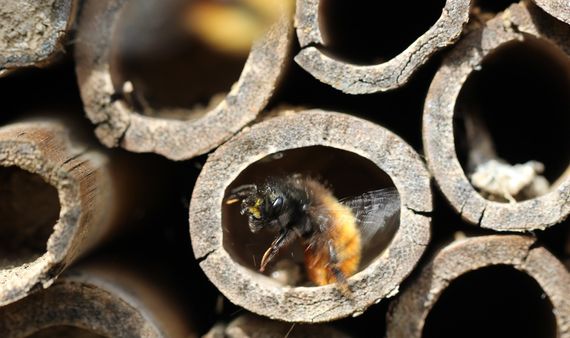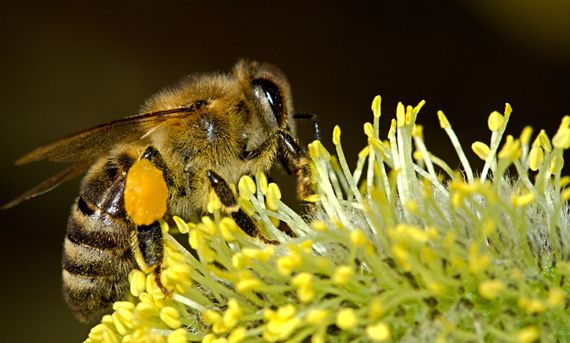In 1872, Charles Darwin proposed that animals expressed emotions, for which he was bombarded with criticism and even ridicule. Until then, every species other than human was considered little more than an animate object, a beast programmed only for the satisfaction of its instincts. But the father of evolutionary theory could hardly have suspected that the capacities of animals go much further: in recent years, research has revealed the abilities of many species to do mathematics, something that we used to think was exclusively human. And a primate’s complex brain is not even required for this feat: with less than a million neurons —compared to our 86 billion— bees are able to learn the abstract fundamentals of mathematics.
When we sense them buzzing annoyingly around us, one would scarcely think that bees are capable of anything more than looking for flowers to sip their nectar. Over the years, however, science has taught us that their dance involves a complex communication system capable of encoding the route, the distance and the direction towards a food source, which requires not only a recognition of the surroundings and a solid memory, but also a process of abstraction. In 2012, a study showed that these abilities are based on the capacity of bees to understand concepts such as up/down, left/right or the same/different.
And if this were not enough of an achievement for a brain of just half a millimetre, in 2018 Adrian Dyer and his collaborators at the RMIT University of Melbourne (Australia) discovered that honey bees can count. The researchers trained the insects to distinguish between different quantities of geometric shapes, such as squares or circles, so that they had to choose the smallest number from 1 to 6.
Trained to understand the zero
Training bees is actually quite simple; you just need to place before them two possible paths labelled with two cards, one with the correct option and the other with a wrong one, and reward the correct response with a bit of sweet juice. After many repetitions, the bees end up understanding what the mental rule they must apply is to get the prize. In Dyer’s experiment, a bee was considered to be trained when it was successful at least 80% of the time.

Then the researchers presented the insects with an even greater challenge: to understand the concept of zero. This is not a trivial achievement. According to Dyer, “in our own species there is no written record of calculations with the number 0 until the 7th century of our era”. The Roman numerals lacked a symbol for zero, which first appeared in the 9th century in India and did not reach the West until the 12th century.
In animals, the understanding of zero has only been demonstrated in non-human primates and in the African grey parrot. And yet, trained honey bees were able to understand that a blank card was the right choice —in other words, “less than”— compared to other cards with figures. Moreover, they were more successful when presented with the dilemma of choosing between 0 and 6 than when given the choice of 0 or 1, demonstrating a notion of numerical distance.
According to Dyer, this ability of bees places them at the same level as preschool children in terms of the abstract understanding of zero. “For other animals there needs to be testing to know for sure what is possible, but our studies are very suggestive that brain size is not the major constraint on what abilities an animal can acquire,” he says to OpenMind.
Adding and subtracting
A new experiment by Dyer and his collaborators has revealed an even more amazing mathematical ability in honey bees. In this case, the insects had to show if they were capable of adding and subtracting. To do this they were first presented with a card with a certain number of figures, all of the same colour. The insects had to learn that the key was in the colour: yellow meant subtract 1, while blue was equivalent to add 1. Next, they found two possible paths marked respectively with the correct answer and a wrong one. After the training period, the bees chose the right option up to 72% of the time.

But beyond being a curiosity, it is logical to ask ourselves why bees have this ability. “To collect nectar from many flowers, bees typically have to navigate in complex environments, and we know from previous studies that counting landmarks improves the accuracy of bee orientation,” explains Dyer. “Adding is likely to be of importance for counting, and the ability to both add and subtract likely improves foraging efficiency for resource management.” And all this is possible thanks to the fact that these insects wisely exploit their great visual and cognitive power. As Dyer’s studies have also revealed, bees and wasps individually recognise human faces.
Convergent evolution
Of course, if this mathematical talent exists in bees, is it also present in other species? According to Dyer, it is likely that such skills do not come from a common ancestor between humans and bees, species separated by some 500 million years of evolution, but that they were acquired independently “as a means to solve problems commonly found in nature.”
Therefore, it is a case of convergent evolution, the neurobiologist Andreas Nieder, from the University of Tübingen (Germany), author of the forthcoming book A Brain for Numbers: The Biology of the Number Instinct (MIT Press ), explains to OpenMind. “The brains of insects and vertebrates are very different,” says Nieder. However, many species find advantages in learning mathematics: “Numerical cognition helps individuals to find food and avoid becoming food, but also to pick one’s way through cluttered environment and to count on help from friends.”

Studies indicate that diverse species use their abstract knowledge of numbers for a wide variety of essential functions, from feeding to social interactions. “In addition, numerical competence increases the chances of passing on the right genes during reproduction,” adds Nieder. “The advantages range from monopolising a receptive mate to increasing the chances of fertilising an egg and finally promoting the survival chances of offspring.”
So, the next time we feel tempted to accuse someone of having an insect brain, we should think twice. The insects might understand… and take offence.
Comments on this publication